 The Sun Voyager (Sólfarið) is a large steel sculpture located on by the seaside of central Reykjavík, Iceland. While many believe it to be a Viking ship, it is actually meant to depict a dreamboat that serves as an ode to the sun. The sun ship symbolizes the promise of new, undiscovered territory and has come to have a profound influence on the culture of Reykjavík while generating a profound direct and indirect economic impact.
The Sun Voyager (Sólfarið) is a large steel sculpture located on by the seaside of central Reykjavík, Iceland. While many believe it to be a Viking ship, it is actually meant to depict a dreamboat that serves as an ode to the sun. The sun ship symbolizes the promise of new, undiscovered territory and has come to have a profound influence on the culture of Reykjavík while generating a profound direct and indirect economic impact.

An Ode to the Sun
In 1986 the district association of Reykjavik funded a competition for an outdoor sculpture to celebrate the city’s 200 year anniversary. Icelandic sculptor Jon Gunnar Arnason won the competition with his idea for the Sun Voyager, which was inspired by his experience with the history of the origins of Icelanders.
 Sun Voyager is described as a dreamboat, or an ode to the Sun. Arnason intended it to convey the promise of undiscovered territory, a dream of hope, progress and freedom. Despite this focus, Arnason has also stated that all works of art should convey a message that transcends the work itself. He believed it is the observer who bears the eventual responsibility for interpreting the works in their own way, thus becoming a participant in the overall creation of the work. In this way, residents and visitors can define the sculpture in whatever way makes sense to them to connect with the piece in a powerful manner.
Sun Voyager is described as a dreamboat, or an ode to the Sun. Arnason intended it to convey the promise of undiscovered territory, a dream of hope, progress and freedom. Despite this focus, Arnason has also stated that all works of art should convey a message that transcends the work itself. He believed it is the observer who bears the eventual responsibility for interpreting the works in their own way, thus becoming a participant in the overall creation of the work. In this way, residents and visitors can define the sculpture in whatever way makes sense to them to connect with the piece in a powerful manner.
Facing north across Faxaflói Bay and providing an incredible view of Mount Esja, the Sun Voyager has become a popular feature for residents and visitors to interact with which has positively impacted the culture and economy of Reykjavík.

One of Reykjavik‘s Most Visited Sights
The Sun Voyager has proven to be a popular attraction for tourists, with some claiming it to be one of the most visited sights in the capital. Various other icons of Reykjavik are within walking distance of the Sun Voyager, including the Hallgrímskirkja that features the Leif Erickson Statue as well as the Harpa Concert Hall.
 That popularity has seen it become a feature on maps and tours of the city, providing visitors with an attraction that compels them to visit the area. Like other sculptures that encourage personal interaction, the Sun Voyager allows audiences to get close to and touch the piece to experience it on a personal level to help fuel a profound indirect economic impact for the city and region.
That popularity has seen it become a feature on maps and tours of the city, providing visitors with an attraction that compels them to visit the area. Like other sculptures that encourage personal interaction, the Sun Voyager allows audiences to get close to and touch the piece to experience it on a personal level to help fuel a profound indirect economic impact for the city and region.
Numerous hotels and restaurants are located within the vicinity of the Sun Voyager, further showcasing the kind of positive economic impact that monuments of this type can generate. The coastal path that the Sun Voyager is located on is very popular with joggers and cyclists, further signifying its’ connection to the local community.
The sculpture has created a direct economic impact as well, as quality replicas of the Sun Voyager are available in three different sizes, with a full online shop that contains these and various other items. The two larger ones, made ready for easy assembly, are engraved with the name of the work and its author. The smallest replica is made by Precyzja in Poland and the larger ones by Geislatækni in Iceland.
Free to visit and easy to interact with, the Sun Voyager has become an essential item on every list of things to do in Reykjavík. In doing so, it has come to showcase what it can mean to turn a nondescript location with a city into something monumentous.

A Landmark in Reykjavík
 Sculptures of all types can come to represent cities and entire countries, but the Sun Voyager isn’t so much about identity as it is opportunity. What was just another empty spot along the coast now attracts visitors from all over the world to experience an ode to the history and culture of Iceland even though the piece can be interpreted in so many different ways.
Sculptures of all types can come to represent cities and entire countries, but the Sun Voyager isn’t so much about identity as it is opportunity. What was just another empty spot along the coast now attracts visitors from all over the world to experience an ode to the history and culture of Iceland even though the piece can be interpreted in so many different ways.

